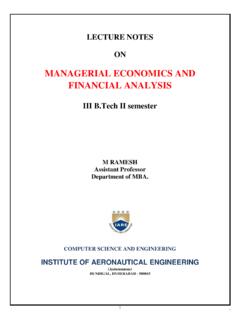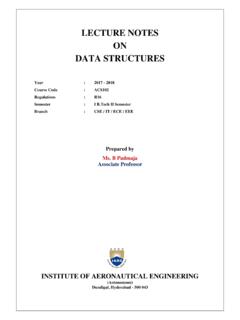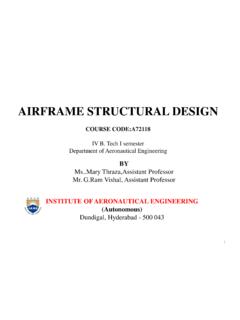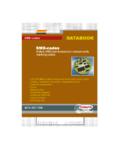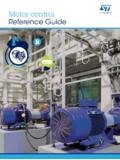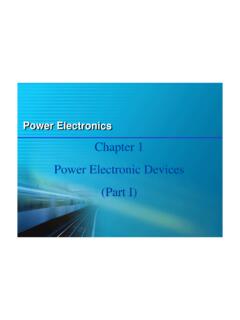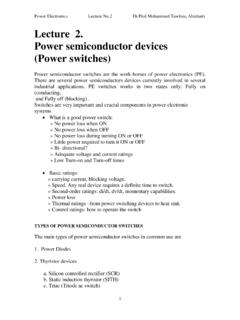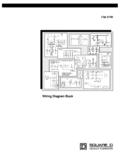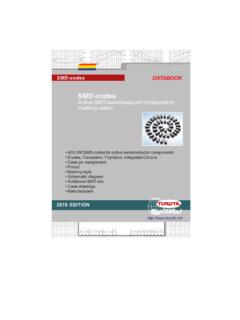Transcription of ELECTRONIC DEVICES AND CIRCUITS B.Tech IIIsemester …
1 LECTURE NOTES ON ELECTRONIC DEVICES AND CIRCUITS IIIsemester (Common for ECE/EEE) Dr. Babu, Professor Mr. V R Seshagiri Rao, Professor Mr. Reddy, AssosciateProfessor ELECTRONICS AND COMMUNICATION ENGINEERING INSTITUTE OF AERONAUTICAL ENGINEERING (Autonomous) DUNDIGAL, HYDERABAD - 500043 Mr. , AssosciateProfessor ELECTRONIC DEVICES AND CIRCUITS III Semester: ECE Course Code Category Hours / Week Credits Maximum Marks AEC001 Foundation L T P C CIA SEE Total 3 1 - 4 30 70 100 Contact Classes: 45 Tutorial Classes: 15 Practical Classes: Nil Total Classes: 60 OBJECTIVES: The course should enable the students to: 1. Be acquainted with electrical characteristics of ideal and practical diodes under forward and reverse bias to analyze and design diode application CIRCUITS such as rectifiers and voltage regulators.
2 2. Utilize operational principles of bipolar junction transistors and field effect transistors to derive appropriate small-signal models and use them for the analysis of basic amplifier CIRCUITS . 3. Perform DC analysis (algebraically and graphically using current voltage curves with super imposed load line) and design of CB,CE and CC transistor CIRCUITS . 4. IV. Compare and contrast different biasing and compensation techniques UNIT-I SEMICONDUCTOR DIODES Classes: 08 PN Junction Diode : Theory of PN diode, energy band diagram of PN diode, PN junction as a diode, operation and V-I characteristics , static and dynamic resistances, diode equivalent CIRCUITS , diffusion and transition capacitance, diode current equation, temperature dependence of V-I characteristics, Zener diode characteristics ,break down mechanisms in semiconductor diodes, Zener diode as a voltageregulator.
3 UNIT-II SPECIAL purpose ELECTRONIC DEVICES AND RECTIFIERS Classes: 10 Special purpose ELECTRONIC DEVICES : principles of operation and characteristics of silicon controlled rectifier , tunnel diode, varactor diode, photodiode; Half wave rectifier , full wave rectifier , general filter consideration, harmonic components in a rectifier circuit , Inductor Filter, capacitor filter, L-Section filter, multiple L-C section, RC filter, comparison of filters. UNIT-III TRANSISTORS Classes: 08 Bipolar Junction Transistors: Construction of BJT, operation of BJT, minority carrier distributions and current components, configurations, characteristics, BJT specifications; Applications: Amplifier,switch. Field Effect Transistors: Types of FET, FET construction, symbol, principle of operation, V-I characteristics, FET parameters, FET as voltage variable resistor, comparison of BJT and FET; MOSFET construction and operation; Uni-Junction Transistor: Symbol, principle of operation, characteristics, applications (UJT as relaxation oscillator).
4 UNIT-IV BIASING AND COMPENSATION TECHNIQUES Classes: 10 Need for biasing, BJT operating point, The DC and AC load lines, types of biasing CIRCUITS , bias stability, stabilization factors, stabilization against variations in VBE and ; Bias compensation techniques, thermal runaway, thermal stability, biasing the FET and MOSFET. UNIT-V BJT AND FET AMPLIFIERS Classes: 09 BJT small signal analysis, BJT hybrid model, determination of characteristics, transistor amplifiers analysis using h- parameters; F common source amplifier, FET as common drain amplifier, FE generalized FET amplifier . h-parameters from transistor ET small signal model, FET as T as common gate amplifier, Text Books: 1. J. Millman, , Millman s Integrated Electronics , Tata McGraw-Hill, 2nd Edition, 2001.
5 2. J. Millman, , Satyabrata Jit, Millman s ELECTRONIC DEVICES and CIRCUITS , Tata McGrawHill, 2nd Edition, 1998. 3. David A. Bell, ELECTRONIC DEVICES and CIRCUITS , Oxford University Press ,5th Edition,2008. Reference Books: 1. , A Text Book of Applied Electronics , Sultan Chand Publishers ,1st Edition, 2008 2. R L. Boylestad, Louis Nashelsky, ELECTRONIC DEVICES and CIRCUITS , PEI/PHI , 9th edition, , 3. Electron DEVICES and CIRCUITS , & Sons , 2nd Edition,2012. Salivahanan, N. Suresh Kumar,A. Vallavaraj. Web References: E-Text Books: (PDF-313p).html (EDC)-by- J-B-Gupta-full-book-pdf 1 UNIT 1 PN JUNCTION DIODE INTRODUCTON Based on the electrical conductivity all the materials in nature are classified as insulators, semiconductors, and conductors.
6 Insulator: An insulator is a material that offers a very low level (or negligible) of conductivity when voltage is applied. Eg: Paper, Mica, glass, quartz. Typical resistivity level of an insulator is of the order of 1010 to 1012 -cm. The energy band structure of an insulator is shown in the Band structure of a material defines the band of energy levels that an electron can occupy. Valance band is the range of electron energy where the electron remain bended too the atom and do not contribute to the electric current. Conduction bend is the range of electron energies higher than valance band where electrons are free to accelerate under the influence of external voltage source resulting in the flow of charge.
7 The energy band between the valance band and conduction band is called as forbidden band gap. It is the energy required by an electron to move from balance band to conduction band the energy required for a valance electron to become a free electron. 1 eV = x 10-19 J For an insulator, as shown in the there is a large forbidden band gap of greater than 5Ev. Because of this large gap there a very few electrons in the CB and hence the conductivity of insulator is poor. Even an increase in temperature or applied electric field is insufficient to transfer electrons from VB to CB. 2 o Insulator Semiconductor Conductor Energy band diagrams insulator, semiconductor and conductor Conductors: A conductor is a material which supports a generous flow of charge when a voltage is applied across its terminals.
8 It has very high conductivity. Eg: Copper, Aluminum, Silver, Gold. The resistivity of a conductor is in the order of 10-4and 10-6 -cm. The Valance and conduction bands overlap ( ) and there is no energy gap for the electrons to move from valance band to conduction band. This implies that there are free electrons in CB even at absolute zero temperature (0K). Therefore at room temperature when electric field is applied large current flows through the conductor. Semiconductor: A semiconductor is a material that has its conductivity somewhere between the insulator and conductor. The resistivity level is in the range of 10 and 104 -cm. Two of the most commonly used are silicon (Si=14 atomic no.) and germanium (Ge=32 atomic no.)
9 Both have 4 valance electrons. The forbidden band gap is in the order of 1eV. For eg., the band gap energy for Si, Ge and GaAs is , and eV, respectively at absolute zero temperature (0K). At 0K and at low temperatures, the valance band electrons do not have sufficient energy to move from V to CB. Thus semiconductors act a insulators at 0K. as the temperature increases, a large number of valance electrons acquire sufficient energy to leave the VB, cross the forbidden bandgap and reach CB. These are now free electrons as they can move freely under the influence of electric field. At room temperature there are sufficient electrons in the CB and hence the semiconductor is capable of conducting some current at roomtemperature. Inversely related to the conductivity of a material is its resistance to the flow of charge or current.
10 Typical resistivity values for various materials are given as follows. CB VB VB Eo = 6eV CB VB Forbidden band gap Eo 6eV CB 3 Insulator Semiconductor Conductor 10-6 -cm (Cu) 50 -cm (Ge) 1012 -cm (mica) 50x103 -cm (Si) Typical resistivity values SemiconductorTypes A pure form of semiconductors is called as intrinsic semiconductor. Conduction in intrinsic sc is either due to thermal excitation or crystal defects. Si and Ge are the two most important semiconductors used. Other examples include Gallium arsenide GaAs, Indium Antimonide (InSb) etc. Let us consider the structure of Si atomic no. is 14 and it has 4 valance electrons. These 4 electrons are shared by four neighboring atoms in the crystal structure by means of covalent bond.

